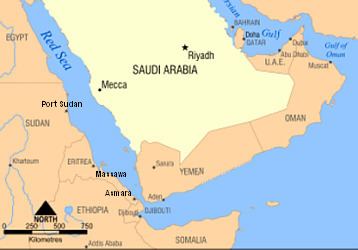Active to June 1940 Disbanded April 1941 | Country Italy Branch Regia Marina | |
 | ||
Size 7 destroyers, 8 submarines, 5 motor torpedo boats and auxiliary ships Commander Carlo Balsamo di Specchia Normandia (1939-December 1940)Mario Bonetti (December 1940-April 1941) Similar Regia Marina, Gideon Force, Middle East Command, Desert Air Force, Sudan Defence Force | ||
The Red Sea Flotilla was a unit of the Italian Royal Navy (Regia Marina Italia) based in Massawa, Eritrea, when Massawa was part of Italian East Africa. In World War II, the Red Sea Flotilla was active against the British Royal Navy East Indies Station from Italy's declaration of war on 10 June 1940 until the fall of Massawa on 8 April 1941.
Contents
- Purpose and organization
- Actions
- Destroyers motor torpedo boats MAS and submarines
- Other vessels
- References
The location of the squadron meant it was isolated from the main Italian bases in the Mediterranean by distance and British dispositions. The British capture of Massawa and other Italian ports in the region ended the Italian naval presence in the region in April 1941.
Purpose and organization
While, in general, the Red Sea Flotilla was not used aggressively by the Italians, the British viewed it as a potential threat to Allied convoys travelling East African waters between the Mediterranean Sea and the Indian Ocean. This was a vital route for British forces operating from Egypt. The Red Sea Flotilla was especially well situated to attack convoys headed from the Gulf of Aden through the Red Sea and to the Suez Canal, after the Mediterranean was closed to Allied merchant ships, which had to take a much longer passage around the Cape of Good Hope.
On 10 June 1940, the day Italy declared war, the Italian Red Sea Flotilla had seven destroyers organized into two squadrons, a squadron of five Motor Torpedo Boats (Motoscafo Armato Silurante, or MAS) and eight submarines organized into two squadrons. The main base was at Massawa, with other bases at Assab (also in Eritrea) and Kismayu, in southern Italian Somaliland.
Actions
Several attempts were made to stage offensive actions against the British Royal Navy and Allied convoys from Massawa. Some of the earliest failed when submarine air conditioning systems, intended to reduce temperatures in the warm water of the Red Sea. proved dangerous under wartime operating conditions. Leakage of chloromethane refrigerants caused central nervous system poisoning in the recirculating air during submerged operations and about twelve sailors died aboard Archimede. Perla and Macallè ran aground while their crews were intoxicated and the latter could not be salvaged. Galileo Galilei, Torricelli and Galvani struck early; Galilei sank the Norwegian freighter James Stove off Djibouti, before British counter measures forced the submarines to depart the area.
Torricelli was spotted on 23 June, while approaching Massawa and an intensive search ensued involving four warships and aircraft from Aden. After a fierce resistance on surface, during which the sloop HMS Shoreham was damaged by return fire, Torricelli was sunk. After the engagement, the destroyer HMS Khartoum was destroyed by an internal explosion. As a mark of respect for Torricelli crew's gallantry, the Italian captain was guest of honour at a dinner at the British naval base. Galilei had also been found on 18 June, captured and taken to Aden on the same day. Galvani sunk HMIS Pathan at the same time that her sisters were fighting and was herself sunk on the following day.
The destroyers based at Massawa conducted the Attack on convoy BN 7 a 32-ship convoy, with negligible results in October 1940. The convoy's escort beat off the attack and Nullo was driven ashore and sunk by air attack the following day. On the British side, only the leading transport ship of the convoy sustained minor splinter damage, while HMS Kimberley was crippled by Italian shore batteries, with three wounded among her crew and had to be towed to Aden by the cruiser HMNZS Leander.
As Italian fuel supplies in Massawa dwindled, so did the offensive capability of the Red Sea Flotilla. Ultimately, the vessels of the flotilla became what is known as a "fleet in being", offering a threat without action, and rarely left port. In late March 1941, the three large destroyers, Leone, Pantera and Tigre, were to attempt a night attack on Suez but Leone ran aground off Massawa and had to be scuttled by gunfire. The delay caused the operation to be cancelled. Instead the two remaining ships joined three smaller destroyers - Battisti, Manin and Sauro, on a final raid on Port Sudan in early April. Engine problems kept Battisti in port, where she was subsequently scuttled to prevent her capture by the British. The Italian ships were spotted by aircraft while en route and came under attack from land and carrier based aircraft. Pantera and Tigre were scuttled on the Arabian coast and Manin and Sauro were sunk by Fairey Swordfish aircraft.
On 6 April 1941, the light cruiser HMS Capetown was torpedoed and crippled by the Italian motor torpedo boat MAS 213 off Massawa.
The armed merchant cruisers Ramb I, Ramb II and the colonial despatch ship Eritrea were ordered to escape and reach Japan. Ramb II and Eritrea reached Kobe successfully but Ramb I was intercepted and sunk by Leander. The four Italian submarines that had survived were ordered to join the Italian submarine flotilla at Bordeaux, which they all did successfully, despite concerted British attempts to intercept them. On 8 April 1941, Massawa fell to the British and the Red Sea Flotilla ceased to exist for all intents and purposes. Few vessels of the flotilla survived the East African Campaign.
Destroyers, motor torpedo boats (MAS), and submarines
Seven destroyers were organized into two divisions:
The five MAS were organized as follows:
The eight submarines were organized in the 8th Submarine Group as follows:
